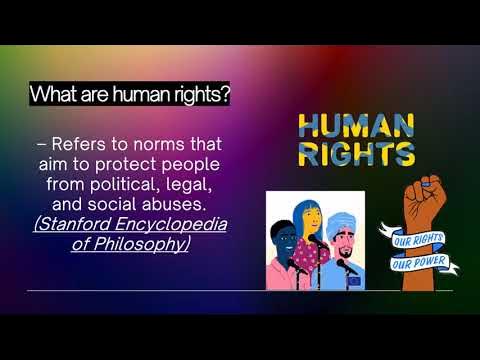HR Lecture 9
Summary
TLDRThis video concludes a series on human rights by exploring the obstacles faced in implementing human rights in India, such as inequality, population pressure, poverty, and the caste system. The speaker emphasizes the importance of good governance principles like transparency, rule of law, and accountability. Advocacy groups, including media, lawyers, educational institutions, the corporate sector, and NGOs, play a vital role in promoting human rights by raising awareness, providing legal actions, and ensuring government responsiveness. Ultimately, the video stresses the need for collective efforts to overcome these challenges and uphold human rights across the country.
Takeaways
- 😀 Inequality in India, such as divisions based on religion, caste, gender, and poverty, creates significant obstacles to human rights implementation.
- 😀 India's large population puts immense pressure on the legal and judicial systems, making the enforcement of human rights more difficult.
- 😀 Poverty in India is not only about low income but also includes deficiencies in education, healthcare, and access to communication, which further hinder human rights progress.
- 😀 The caste system, despite legal reforms, remains a persistent barrier to full legal redress and human rights implementation in India.
- 😀 Abuse of executive power, including corruption, nepotism, and favoritism, impedes equality and the proper functioning of human rights protections.
- 😀 Good governance in India is based on principles such as participation, the rule of law, efficiency, transparency, accountability, and inclusiveness.
- 😀 The rule of law is crucial for ensuring that laws are applied equally to all, regardless of status, and no one is above the law, including government officials.
- 😀 Effective governance should be transparent, with clear visibility on how resources are managed, and accountable to the public.
- 😀 Advocacy groups like the media, lawyers, educational institutions, the corporate sector, and NGOs play essential roles in promoting and safeguarding human rights in India.
- 😀 Media acts as a watchdog, holding the government accountable for its actions and helping correct mistakes through public pressure.
- 😀 Lawyers contribute to human rights implementation by challenging wrongdoings in the legal system and fighting for justice through courts.
- 😀 Educational institutions help raise awareness of human rights, fostering understanding among students and future leaders.
- 😀 The corporate sector must also embrace human rights principles and actively support their implementation in the workplace and society.
- 😀 NGOs are crucial in raising public awareness and implementing human rights across various regions in India, bridging gaps between people and legal systems.
Q & A
What are the main obstacles to implementing human rights in India?
-The main obstacles include inequality (based on religion, caste, gender, and poverty), population growth, poverty, caste-based discrimination, and the abuse of executive power by the government.
How does inequality affect the implementation of human rights in India?
-Inequality creates divisions in society that hinder equal access to legal systems and resources, preventing effective protection and enforcement of human rights.
Why is population growth considered an obstacle to human rights implementation in India?
-With India being the world's most populous country, the sheer number of people places a burden on the legal and governance systems, reducing their effectiveness in ensuring human rights for all.
What role does poverty play in hindering the implementation of human rights?
-Poverty goes beyond low income; it also affects access to health, education, communication, and legal redress, making it difficult for individuals to fully enjoy their human rights.
How does caste-based discrimination impact human rights in India?
-Caste-based discrimination limits individuals' access to justice and legal redress, reinforcing social inequality and obstructing the implementation of human rights.
What is meant by the abuse of executive power, and how does it affect human rights?
-Abuse of executive power refers to corruption, nepotism, and favoritism within government structures. This undermines equality and fairness, making it harder to implement human rights laws effectively.
What are the principles of good governance as mentioned in the script?
-The principles of good governance include participation, rule of law, effectiveness and efficiency, equity and inclusiveness, transparency, accountability, and consensus-oriented decision-making.
Why is participation important in governance when it comes to human rights?
-Participation ensures that people are involved in governance processes, helping to create laws and policies that reflect the needs and rights of all citizens.
What role do advocacy groups play in implementing human rights in India?
-Advocacy groups such as the media, lawyers, educational institutions, the corporate sector, and NGOs play a vital role in raising awareness, holding the government accountable, and helping to ensure the protection and implementation of human rights.
How does the media contribute to human rights implementation in India?
-The media highlights human rights violations, creating public pressure on the government to correct these issues, making it a powerful tool for accountability and reform.
Outlines

Dieser Bereich ist nur für Premium-Benutzer verfügbar. Bitte führen Sie ein Upgrade durch, um auf diesen Abschnitt zuzugreifen.
Upgrade durchführenMindmap

Dieser Bereich ist nur für Premium-Benutzer verfügbar. Bitte führen Sie ein Upgrade durch, um auf diesen Abschnitt zuzugreifen.
Upgrade durchführenKeywords

Dieser Bereich ist nur für Premium-Benutzer verfügbar. Bitte führen Sie ein Upgrade durch, um auf diesen Abschnitt zuzugreifen.
Upgrade durchführenHighlights

Dieser Bereich ist nur für Premium-Benutzer verfügbar. Bitte führen Sie ein Upgrade durch, um auf diesen Abschnitt zuzugreifen.
Upgrade durchführenTranscripts

Dieser Bereich ist nur für Premium-Benutzer verfügbar. Bitte führen Sie ein Upgrade durch, um auf diesen Abschnitt zuzugreifen.
Upgrade durchführenWeitere ähnliche Videos ansehen

From Investigation to Petition: How SC Ruling on Caste Discrimination in Prisons Came to Be

Film La Storia dei Diritti Umani

The Caste System Explained: Origins, Impact, and Modern Relevance

What are the world's largest NGOs?

Peace and Human Rights Concepts

DIREITOS E GARANTIAS FUNDAMENTAIS | Prof. Gustavo Americano
5.0 / 5 (0 votes)
